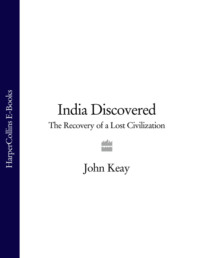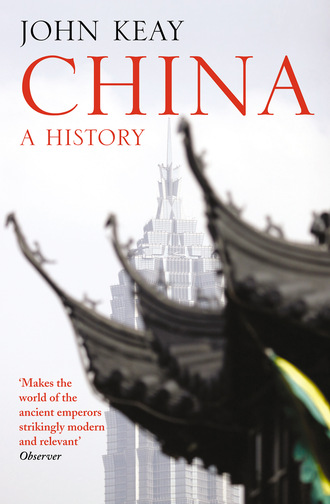
Полная версия
China
For all the lineage boasting, for all the mortuary consumption, the technological precocity, the ritual rectitude and the despotic power, the late Shang kingdom was but a local proto-state and one among many. It may have enjoyed greater dominion prior to 1200 BC but not thereafter. In no way did it anticipate the great unitary empire of ten centuries later. Yet by 1045 BC, the currently preferred date for Shang’s defeat by the Zhou, it had demonstrated many of the cultural traits that have come to be seen as typically, even peculiarly, Chinese; and it may well have been for this reason that later textual tradition selected the Shang for inclusion in that apostolic succession of dynasties.
The emphasis on kinship and lineage, on ancestor-worship, ritual observance and a calendrical system based on these, is obvious. Keightley also notes in the Shang’s ritual dealings what he calls ‘a characteristic this-worldliness’ that would colour later Chinese philosophy and religion.23 The ancestors and the gods had a practical part to play in human affairs; they were not so removed and transcendent as to be credited with impossible responsibilities like the creation of the world or the imposition of moral ‘commandments’; they were there, in and about their tombs and temple-tablets, to be consulted, activated and used – for their example, their wisdom and their considerable influence.
Shang bronze-casting and its astounding artistic achievements provide early evidence of China’s technological genius and aesthetic sophistication; but as is now clear, these skills and sensitivities were not exclusive to the Shang. Writing, on the other hand, may have been. It is remarkable enough that over three thousand years ago the Shang used a script that is recognisably Chinese today; that this script must have had a long pre-Anyang history is even more remarkable; and the use the Shang made of it is especially relevant. From the first, literacy was put to bureaucratic purpose. It was used to record official transactions and so, in effect, to produce historical documentation. Into the new era of textual record in the first millennium BC, literacy, authority and history went hand in hand.
2 SAGES AND HEROES
c. 1050 BC – c. 250 BC.
FOOTPRINTS OF ZHOU
THIRD AND LAST OF THE PRE-IMPERIAL ‘Three Dynasties’ (Xia, Shang, Zhou), the Zhou supplanted the Shang as the supreme power in the lower Yellow River basin in c. 1045 BC. They would still be there nearly 800 years later. In the course of this dynastic marathon some thirty-nine kings followed one another, mostly in orderly father-to-son succession. None of China’s subsequent ruling lineages would last more than half as long; in fact the Zhou probably hold the world record for dynastic longevity.
Yet eight centuries – even BC ones – under a single dynasty could scarcely elapse without witnessing fundamental change. During this long haul the Zhou presided over an explosion in intellectual and artistic creativity that saw the composition of China’s first classic texts and a transformation in society, government, statecraft and warfare. History finally clambers out of the dark burial chambers and the bone-filled sacrificial pits into the fitfully documented light of day. Dates cease to be approximate, territories cease to be disjointed; battle sites can be located and the fortunes of war discerned. Coinage appears; so do public works such as defensive walls and schemes for irrigation and flood control. Horizons expand. New cities are created and more land is brought under cultivation. From the often laconic texts, there emerge recognisable personalities pursuing intelligible careers. Kinship and lineage are no longer the essential requisites for office; professional strategists and diplomats tout their services and tilt the scales of power. From the court, bureaucratic practices spread throughout the civil and military administration. Ritual undergoes what has been called a revolution. Subordinate jurisdictions emerge to parody and humble the mighty Zhou while competing aggressively with one another. State-formation proves, if anything, rather too successful.
In this catalogue of achievement nothing so became the Zhou themselves as their beginning. The early kings would be seen as epitomising ideals of just and virtuous rule, and their conduct would be the most closely studied and frequently cited of any in Chinese history. The later Zhou kings, on the other hand, would be more notable for the calibre of their contemporaries. Theirs was the age of Confucius and other sages, the birth era of Chinese philosophy, and the most fertile in terms of speculative enquiry and rational analysis. The long Zhou centuries, paralleling those of ancient Greece, combine both a heroic age and a classical age. In terms of China’s civilisation, they are seminal times.
Yet they get short shrift in some history books. One substantial and respected work manages to hurdle the Zhou’s eight centuries in as many pages, most of these being devoted to an explanation of the Chinese script and an excursion into world history.1 The Zhou deserve better, although it has to be admitted that their story is poorly served by the surviving texts. ‘These are but the dim footprints of ancient kings,’ declared Laozi, the personification of Daoist (Taoist) teaching, during a supposed conversation with Confucius recorded in the fourth-century BC Zhuangzi. ‘They tell us nothing of the force that guided their [i.e. the ancient kings’] steps…They are made by shoes but they are far from being shoes.’2
Nor is this forensic challenge the only problem facing the historian. Come the texts, come the Chinese penchant for naming names – then renaming (‘rectifying’) them while reappropriating the originals for other purposes. Non-Chinese readers will be appalled by the swarm of same-sounding people, places and titles lying in wait for them. Like those readers wedded to the idea of China’s manifest destiny as a unitary empire, they will be impatient to escape the enigmatic Zhou for their nemesis at the hands of Qin and for the triumphalism of Qin Shi Huangdi, ‘the First Emperor’.
To be fair, Zhou rule, though long, was not often glorious. Initiative deserted all but a handful of kings; their defeats outnumbered their victories, and retraction soon overwhelmed expansion. Arguably Zhou’s eight centuries comprised one of assertion followed by seven of reversion. Stripped progressively of territories, manpower, resources and relevance, they were eventually left with nothing but their legitimacy; had their kingdom been an empire, its protracted decline and fall would have rivalled that of Rome. Perhaps China needed the chaos of Zhou’s last centuries to appreciate the order, and accept the sacrifices, that the Qin experiment in integration would involve. Or perhaps the Zhou centuries tell a different and more controversial story. Their combination of dynastic longevity, intellectual activity and, for the most part, low-level strife, far from demonstrating the necessity of unification, could suggest the vitality of more restricted allegiances and more local cultural traditions. Perhaps it was empire, not multi-state competition, which was the aberration.
Ironically the Zhou themselves, in justifying their initial success, provided a rationale for their eventual downfall. Their origins are disputed, but by the twelfth century BC they had established a jurisdiction in the valley of the Wei, a Yellow River tributary whose corridor of cultivation and passage (the main east–west railway nows runs alongside the Wei) fingers into the hills and deserts of Shaanxi province. It had once been, and may still have been, the western marches of the Shang domain, and it exposed the Zhou to frequent contact with a possibly proto-Tibetan frontier people called the Chiang. Zhou chiefs married Chiang brides, and it was with Chiang support that a Zhou leader, assuming the title of King Wen, challenged the Shang. On a third sortie down the Yellow River valley to the east, Wen’s son and successor, King Wu, engaged the Shang host at a place called Muye. The date, by the latest calculation, was 1045 BC. The Zhou triumphed while the Shang were routed and their king committed suicide. After suppressing further resistance, King Wu of Zhou returned to his Wei valley home (near Xi’an, today another of those cities of 6 million souls) and died there within two years of his victory.
Later commentators, looking back with the benefit of hindsight – not to mention sideways for contemporary approval – had a ready explanation for this success: the Zhou had won Heaven’s approval by their outstanding virtue while the Shang had forfeited it by their extreme degeneracy. Drunkenness, incest, cannibalism, pornographic songs and sadistic punishments enliven the catalogue of liturgical improprieties and governmental omissions later imputed to the last Shang king. Since the virtue that had once led to Shang’s elevation had deserted it, so had its right to rule. Dynasties, like the seasons and the planets, conformed to a cyclical pattern. They ascended and declined at Heaven’s cosmic behest. The Shang were doomed because Heaven had transferred its earthly ‘mandate’ to a worthier and more virtuous lineage. Defeat at Muye was therefore inevitable; indeed, the battle should have been a walkover.
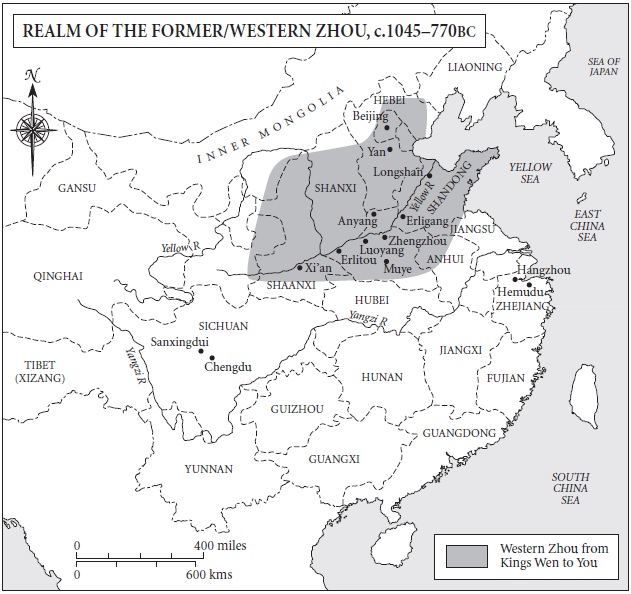
This concept of ‘Heaven’s Mandate’ or ‘Heaven’s Command’ (tian ming) may, though, have been news to the Shang. As revealed in the oracle bones, Shang’s supreme deity had been the stern and awesome Di; ‘Heaven’ as an impersonal and infallible authority receives scarcely a mention in the bone inscriptions. It seems, then, to have been the Zhou who, while for a time retaining Di, introduced this new ‘embryonic philosophy of history’ which would become so fundamental to the legitimacy of every subsequent dynasty that it has been called ‘the cornerstone of the Chinese Empire’.3 As expounded by the Duke of Zhou, a younger brother of the deceased King Wu, power on earth derived from a supreme and impersonal entity called ‘Heaven’; and it came in the form of a devolved ‘mandate’ whose term was finite and in some way contingent on the virtuous conduct of the holder.
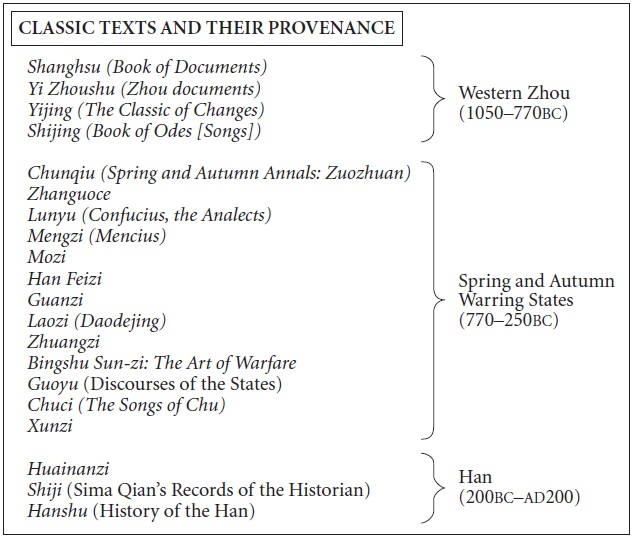
The phrase itself – ‘Heaven’s Mandate’ – first surfaces in a debate reported in the Shangshu that took place after King Wu’s untimely death in c. 1043 BC. Wu’s eldest son, the future King Cheng, was deemed too young or inexperienced to assume the reins of power immediately. A regency council was therefore preferred, and the Duke of Zhou, a consummate leader as well as the brother of the deceased Wu, duly assumed its direction with the support of a half-brother and the young king. But this triumviral arrangement was resented by several other royal brothers, who made common cause with a disgruntled scion of the defeated Shang and withheld recognition. The Zhou, poised on the threshold of power and with vast new territories awaiting their control, could have done without a succession crisis that would rank ‘as a defining moment not only for the Western Zhou but for the entire history of Chinese statecraft’.4
As war threatened, the young King Cheng, doubtless supervised by the doughty Duke of Zhou, consulted the ancestors by turtleshell-cracking. Cheng’s grandfather Wen had done the same when the Zhou had first launched their bid for power. On that occasion Heaven had smiled on ‘our raising up our little country of Zhou’; divination, in other words, confirmed the propriety of action. The same procedure now produced an equally reassuring reply; to a ‘charge’ about engaging the rebels, the cracked response was read as ‘auspicious’. ‘And so expansively I will take you east to campaign,’ declared the young king, ‘Heaven’s Mandate is not to be presumed upon; [but] the divination is aligned like this [in other words, favourably]’.5
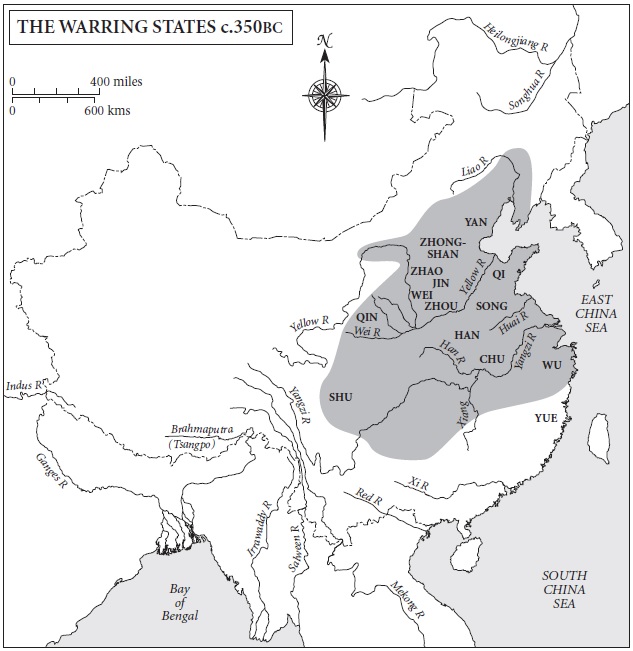
War followed, and since the rebellious brothers were governing territories in what had once been Shang’s central domains, the Zhou royal forces again swept east down the Yellow River, routing the enemy and not stopping this time until they reached the sea in Shandong province. An area of over 1,600 kilometres (1,000 miles) long by several hundred deep, in fact most of ‘the cradle’ that was north China, was now at Zhou disposal.
The victors parcelled it out among their kinsmen and commanders in the form of subordinate fiefs, many of which would become hereditary. From this division of the spoils were born the territorial units that would develop into states under the later Zhou and, later still, would provide the dynasties of imperial China with a handy checklist from which to select a dynastic name. They included, to the north of the Yellow River, Yan (near modern Beijing) and Jin, which would disintegrate into Han, Wei and Zhao; also Qi and Lu in Shandong (the first conferred on King Wen’s Chiang ally, the second on the Duke of Zhou’s son); and numerous lesser entities such as Tang and Song (where a contrite Shang leader was reinstated).
The history and geography of these states are not especially relevant at this point; but the way their names echo down through the centuries is notable. Most later dynasties would look back to the Zhou and to the states they had unwittingly created as a prime source of legitimisation. Besides appropriating their names – hence the later imperial dynasties of Jin, Wei, Tang, Song, etc. – great imperial houses might also claim descent from their ruling lineage or regional association with it. Either way, Zhou and its subordinate states came to embody an archaic authenticity out of all proportion to their achievements. Perceived as favoured exemplars, they conferred incontestable prestige and would be shamelessly exploited for it.
Just one exception may be noted. Established by the Zhou a century later on the steppe-land borders of Gansu province, the horse-breeding fief called Qin would seldom attract endorsement from posterity’s dynastic giants. Though becoming a state, a kingdom and then an empire, Qin as a name would be little commandeered by others and, until the twentieth century, no orthodox Chinese ruler would care to be associated with it. Throughout most of history the royal Zhou so outranked the imperial Qin in heavenly kudos that they were often considered polar opposities. The Zhou, despite – or possibly because of – their tolerance of a ‘feudal’ federalism, were reckoned virtuous; and the Qin, with their aggressive centralism, were not. Only when patriotic nationalists revived the memory of Qin’s first ever unification of China, and when Marxists and Maoists discovered the revolutionary credentials of its despotic instigator – not to mention terracotta evidence of his awesome power – would Qin cease to be a dirty word.
Following its comprehensive victory, the Zhou triumvirate headed by the Duke of Zhou founded an alternative capital near Luoyang in Henan province in what, to the Zhou, were then distant eastern regions. There, in c. 1035 BC after seven years as de facto regent, the wily Duke of Zhou stepped down from his management of affairs, declined to return to the ancestral capital in the west, and handed back the reins of power to the legitimate ruler, King Cheng. This act would be seen as one of magnificent abnegation and is that for which the Duke is most revered. Having steered the Zhou through their greatest crisis, presided over the creation of the kingdom, and largely formulated its heavenly rationale, the Duke could rather easily have usurped the throne. That he did not was convincing proof of superior virtue and would win him a reputation that almost eclipsed that of Kings Wen, Wu and Cheng. Historians without exception would exalt his memory and moralists would cherish his example; in The Analects, or ‘Sayings’, of Confucius the ageing philosopher is reported to have sighed: ‘How I have gone downhill! It has been such a long time since I dreamt of the Duke of Zhou.’6
But whether the Duke really stepped aside, or whether he was pushed, is unclear. He may, it seems, have had a slightly different interpretation of the Heavenly Mandate to that of his fellow triumvirs. In another debate on the subject, he insists that the Mandate had passed from the Shang to ‘the Zhou people’, not just their king, and in particular to those Zhou people who, like himself, advised and instructed the king in the ways of virtue. This has been taken as a plea for a meritocracy – rule by those of proven ability and character – and it could imply greater empowerment of the bureaucracy and of enfeoffed officialdom. But it was not accepted by the Duke’s colleagues, who trumped it with a reference to divination. Since only the king could consult Heaven directly, only he could enjoy the Mandate. As the chosen son of the senior Zhou lineage, he already, in a sense, embodied ‘the Zhou people’. In the familial terms so dear to Confucianists he was both his people’s father and ‘Heaven’s Son’, a formulation that like the Mandate itself would be adopted by all subsequent rulers.
Yet whether this uniquely privileged status should be seen as a charter for autocracy, or whether as a check to it, would continue to be debated – and still is. If Heaven’s Son was accountable only to Heaven, he could afford to ignore advice. If, however, the Mandate depended on the virtue with which it was exercised, he needed to be more circumspect. Virtue was assessed in terms of the welfare of the state and its people. ‘Heaven’s love for the people is very great [says a character in the third-century BC Zuozhuan]. Would it then allow one man to preside over them in an arrogant and wilful manner, indulging his excesses and casting aside the nature Heaven and Earth allotted them? Surely it would not!’7 Hence, were the ruler (after warnings in the form of portentous defeats, civil discontent or natural disasters) not to mend his ways, the Mandate would automatically slip from his grasp. It could then legitimately be claimed by someone else. Under such circumstances it could be construed not as a charter for absolutism but as an invitation to revolt. Whether or not that was his intention, the Duke of Zhou had opened a can-shaped ding of constitutional worms.
King Cheng, delivered at last from his ducal uncle’s machinations, ruled uneventfully for over thirty years (c. 1035–c. 1003 BC). As his dying testament he left an admonition that would be long cherished and might usefully serve as an epitaph for the early Zhou: ‘Make pliable those distant and make capable those near. Pacify and encourage the many countries, large and small.’8 King Kang (r. c. 1003–c. 978 BC), Cheng’s son and a contemporary of the biblical King David, heeded the advice, and while more inclined to encouragement than pacification, presided over a vast and flourishing kingdom. It was not until the reigns of his son and grandson, Kings Zhao (r. c. 977–c. 957 BC) and Mu (r. c. 956–c. 918 BC), that Zhou authority would experience its first setbacks.
Unfortunately for the historian, although avid diviners, the Zhou rarely troubled to inscribe their fire-cracked turtleshells with a written summary of ‘charge’ and response. But such information may have been recorded on less durable materials, for this was almost certainly the case with oracular communications conducted using a new and increasingly preferred medium. Kinder to turtles, the new medium involved a random disposition of sticks, which could be reused. The sticks were stalks of the yarrow plant or milfoil, and they were cast, perhaps like spillikins, six at a time, so that they fell to form hexagrams (six-sided figures) that the diviner then interpreted. Much lore, some art and some mathematics were involved; but it is safe to assume that the results were written down because the ‘reading’ of hexagrams provided the inspiration for ‘The Book of Changes’ (Zhou yi or Yijing, I-ching). This classic text, recorded in the ninth century BC, consists of verses that incorporate divinatory terms plus images that may have been those that the diviner ‘read’ in the hexagrams.
They also employ a technique typical of Chinese verse, and indeed literature and art as whole, which engages the reader by juxtaposing, or correlating, naturalistic images with human concerns to delightfully subtle, if sometimes obscure, effect. The same associative technique appears in another near-contemporary (but non-divinatory) classic. This is ‘The Book of Songs’ (Shijing, also called ‘The Book of Odes’), on which Confucius is supposed later to have worked. The first of the ‘Songs’ – mostly ritual hymns, heroic verses and pastoral odes – provides a standard example of the correlational technique. The mewed call of an osprey is juxtaposed with a marriage proposal to convey, through terse imagery, onomatopoeia and pun (all largely lost in translation), a heavy sense of sexual expectation.
Guan, guan cries the osprey
On the river’s isle.
Delicate is the young girl:
A fine match for the lord.9
(More than two millennia later, this same poem remained part of an educated person’s repertoire. In The Peony Pavilion, a play written in 1598, the demure heroine experiences a sexual wanderlust when her tutor introduces her to it; or as her maid puts it to the tutor in a delightful English translation: ‘Your classical exegesis/Has torn her heart to pieces.10)
Classics like the Shijing and Yijing reveal aspects of ritual practice and social life in early first-millennium BC China as well as the prevalence and development of literary culture. Historians, of course, would prefer something more factual and, as if to oblige, the Zhou compensated for their inarticulate oracle shells by incorporating inscriptions on their bronzes. Some of these are of considerable length and feature events or personalities known from other textual sources. They have been of great assistance in extending the chronology of the Zhou, which is famously anchored on an eclipse recorded in the texts and identified astronomically as occurring in 841 BC, ‘the first absolute date in Chinese history’.
Most of the bronze inscriptions describe, or simply record, the bestowal of gifts, honours, offices, commands or lands. Taken in conjunction with stylistic changes in the bronzes themselves, with their archaeological setting and its wide distribution, and with later textual information, they confirm that, in the words of Jessica Rawson, ‘the Zhou achievement was truly remarkable’. Although ‘too little considered…[it] imprinted itself indelibly, not only on its own day, but on all succeeding generations’.11
LESS SPRING THAN AUTUMN
Painstaking analysis of Zhou mortuary sites and buried hoards, both of them rich in bronzes, has led Rawson to another conclusion: that an extraordinary change, indeed ‘a revolution’, overtook Zhou ritual practice in the first years of the ninth century BC. Quite suddenly bronze vessels became larger and more standardised in form, and they often comprised sets of identical items; their designs betrayed an interest in recreating archaic forms; their inscriptions were much more formulaic than previously; and they were accompanied by a new repertoire of bronze bells and jades.
It was a ritual ‘revolution’ to the extent that these changes implied a grander, noisier and more staged liturgy under firmer central control and involving greater public spectacle. Its standardisation throughout the northern ‘Central Plain’ must have owed something to better communications; cultivation was evidently being extended and neighbouring fiefs were beginning to abut. Moreover, the inscribed bronzes were apparently doubling as archival records, like the Shang’s oracle bones, and being collected, displayed and hoarded as prestigious family heirlooms. But since they recorded royal favours, those who cherished them, and who in some cases had actually had them cast, were not their royal donors but their recipients, some of comparatively humble origin. The Zhou, in other words, were broadening their base of support while enhancing their own precedence.







